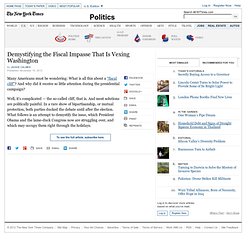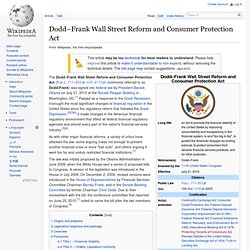

The US 'fiscal cliff' explained. The ‘Fiscal Cliff,’ Explained. Well, it’s complicated — the so-called cliff, that is.

And most solutions are politically painful. In a rare show of bipartisanship, or mutual protection, both parties ducked the debate until after the election. What follows is an attempt to demystify the issue, which President Obama and the lame-duck Congress now are struggling over, and which may occupy them right through the holidays. Q. What is the fiscal cliff? Dodd–Frank Wall Street Reform and Consumer Protection Act. The Dodd–Frank Wall Street Reform and Consumer Protection Act (Pub.L. 111–203, H.R. 4173; commonly referred to as Dodd-Frank) was signed into federal law by President Barack Obama on July 21, 2010 at the Ronald Reagan Building in Washington, DC.[1] Passed as a response to the Great Recession, it brought the most significant changes to financial regulation in the United States since the regulatory reform that followed the Great Depression.[2][3][4] It made changes in the American financial regulatory environment that affect all federal financial regulatory agencies and almost every part of the nation's financial services industry.[5][6] As with other major financial reforms, a variety of critics have attacked the law, some arguing it was not enough to prevent another financial crisis or more "bail outs", and others arguing it went too far and unduly restricted financial institutions.[7] Origins and proposal[edit] Share in GDP of U.S. financial sector since 1860[9]

File Download Blocked. File Download Blocked.